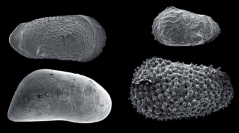

 Geodiversitas
30 (3) - Pages 611-639
Geodiversitas
30 (3) - Pages 611-639A multi-disciplinary study has been carried out on a Late Neogene succession exposed in the SE portion of the Valdelsa Basin (Strolla Creek, Central Italy). The succession consists of upper Tortonian-Messinian sediments, unconformably overlain by uppermost Messinian-Pliocene deposits, accumulated in alluvial, lacustrine and marine environments. Previous studies on this succession hypothesized a sudden marine flooding of the upper Messinian Lago-Mare realm in the earliest Zanclean in apparent agreement with the Mio-Pliocene transition recorded elsewhere in the Mediterrranean Basin. Data from this study suggest a more complex stratigraphy recording a local depositional evolution possibly driven by interference between uplift, relief denudation and eustacy. The sediments encompassing the Mio-Pliocene transition have been included into the Borro Strolla synthem, furtherly subdivided into three sub-synthems. The Borro Strolla synthem has been dated as uppermost Messinian-earliest Zanclean based on the integration of physical stratigraphy, facies analysis and biochronology of non-marine fossil assemblages in part documented for the first time. The occurrence in the lower Borro Strolla Synthem of the gerbil Debruijnimys sp. and the murid Stephanomys aff. S. donnezani (Depéret, 1890) with Pliocene affinity represents the most important novelty in the composition of a mammal fauna otherwise similar to other Italian late Messinian sites. The co-occurrence of terrestrial molluscs from the same sediments gives further biochronologic constrains supporting the calibration of the Borro Strolla synthem to the latest Messinian-earliest Zanclean. The Borro Strolla stratigraphic section then is discussed in the framework of local to regional events which marked the transition from the Messinian to Pliocene.
Late Messinian, early Zanclean, Lago-Mare, non-marine fossil assemblages, facies analysis, Valdelsa Basin, Central Italy